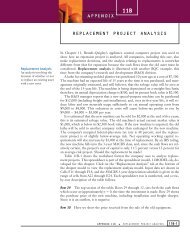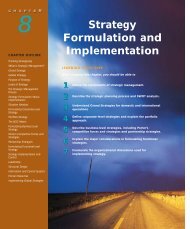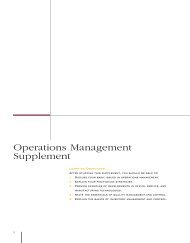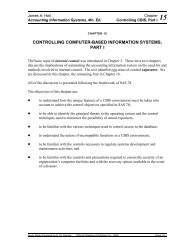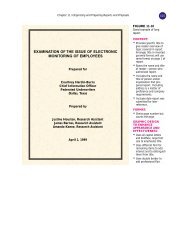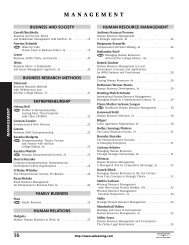The Keynesian Cross
The Keynesian Cross
The Keynesian Cross
Create successful ePaper yourself
Turn your PDF publications into a flip-book with our unique Google optimized e-Paper software.
<strong>The</strong> <strong>Keynesian</strong> <strong>Cross</strong> 13<br />
assumed that the price level was constant, along with other financial variables (like the money<br />
supply) that we didn’t discuss. But now we need to complicate the model in yet another dimension,<br />
allowing the components of aggregate expenditure to depend on the price level. <strong>The</strong> textbook<br />
provides three main reasons for this. Consumption rises when the price level falls, because<br />
people’s real wealth rises (Pigou’s wealth effect). Return and reread the section on autonomous<br />
consumption. Investment rises when the price level falls because interest rates decline (Keynes’s<br />
interest-rate effect). Net exports rise when the price level falls because now domestic goods are<br />
cheaper than foreign goods and interest rates decline and the real exchange rate declines<br />
(Mundell-Fleming’s exchange-rate effect).<br />
<strong>The</strong> effect of different price levels can be seen in Figure 10. Let’s consider three different<br />
price levels, P = 90, P = 100, and P = 110, where P is a price index like the GDP deflator. Suppose<br />
the price level is 100, and suppose at that level of prices, the aggregate expenditure curve is given<br />
as the curve labeled AE(P = 100), shown in the top diagram. <strong>The</strong> equilibrium in the <strong>Keynesian</strong>cross<br />
model occurs at point A. Now we plot point A in the bottom diagram, corresponding to a<br />
price level of 100 and output of $8 trillion.<br />
What happens if the price level falls from 100 to 90? <strong>The</strong> lower price level means higher<br />
aggregate expenditure, so the aggregate-expenditure curve shifts up to AE(P = 90), and the equilibrium<br />
in the <strong>Keynesian</strong>-cross diagram is at point B. So we plot point B in the bottom diagram,<br />
corresponding to price level 90 and output $9 trillion.<br />
Finally, what happens if the price level rises to 110? <strong>The</strong> higher price level means lower<br />
aggregate expenditure, so the aggregate-expenditure curve shifts down to AE(P = 110), and the<br />
equilibrium in the <strong>Keynesian</strong>-cross diagram is at point C. We plot point C in the bottom diagram,<br />
corresponding to a price level of 110 and output of $7 trillion.<br />
Notice that the higher the price level, the lower is aggregate demand. Imagine carrying out<br />
this same experiment for every possible price level. <strong>The</strong>n the points like A, B, and C in the lower<br />
diagram would trace out the entire aggregate-demand curve, as shown.<br />
Shifts in Aggregate Demand<br />
In the previous section, we used the relationship between aggregate expenditure and the price<br />
level to derive the aggregate-demand curve. Now we’ll show that changes in any of the components<br />
of aggregate expenditure that occur for any reason other than a change in the price level<br />
or output lead to a shift of the aggregate-demand curve. To do this, we’ll combine Figures 7 and<br />
10. That is, we’ll start with Figure 10 (but to keep things readable we’ll only draw in one of the<br />
aggregate-expenditure lines in the top half of the figure), then consider what happens when the<br />
autonomous parts of consumption, investment, government purchases, or net exports change,<br />
as we did in Figure 7. Such a change would shift the aggregate-expenditure curve upwards, as<br />
shown in Figure 11, where we denote the original aggregate-expenditure curve AE 1 and the new<br />
aggregate-expenditure curve AE 2 . (You can visualize a similar shift in the other aggregateexpenditure<br />
curves, corresponding to P = 90 and P = 110, drawn in Figure 10.)<br />
Originally we had equilibrium at point A with output of $8 trillion when the price level was<br />
100. After the increase in government spending, the aggregate-expenditure curve shifts up, and<br />
we get equilibrium at point D with output of $8.5 trillion when the price level is 100. Similarly,<br />
for any other given price level, equilibrium output would be higher. So, the new aggregatedemand<br />
curve on the lower diagram has shifted to the right.<br />
<strong>The</strong> aggregate-demand curve can now be combined with a model of aggregate supply in the<br />
economy, as discussed in greater detail in the textbook. As an example, suppose the aggregatesupply<br />
curve is vertical, as it must be in the long run, since the price level has no long-lasting<br />
effect on output. Now, consider our example of an increase in government purchases (or any other



